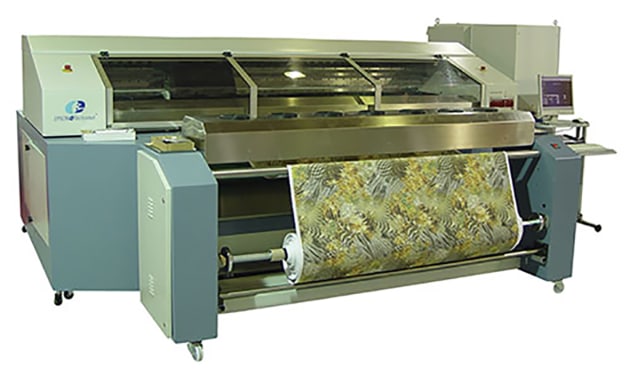MONNA LISA CELEBRATES 20 YEARS
The Epson Monna Lisa textile print system is celebrating two decades in production, with its new entry-level system providing new opportunities for companies looking to move into local, onshore digital printing and production of textiles.
The ML-8000 is the new entry model in the Monna Lisa series, running with eight of the latest PrecisionCore printheads. It reaches typical print speed of up to 155 sqm per hour.

According to Epson, the ML-8000 is a “next-generation digital textile printer with high print quality, productivity, stable operation with minimal downtime, and allows easy operation for an affordable price, for companies looking to move into local, onshore digital printing and production”.
Epson says digital printing has become increasingly popular with fashion and textile designers, as they strive meet the increased demands for short runs and fast fashion, while under pressure from public criticism to ease environmental burdens. The ability to deliver digital designs for digital print on demand enables businesses to offer their customers a faster turnaround without having to rely on mass shipments of stock crossing continents, much of which result in higher waste streams due to analogue printing.

The Monna Lisa is an industrial inkjet digital textile printer jointly developed by Epson and Italian textile manufacturing equipment manufacturer Robustelli.
Robustelli develops, manufactures and sells textile printers in the Como region of Italy, a major centre for the textile printing industry, and the home of many luxury brands. Epson provided Robustelli with inkjet technology, such as Micro Piezo print heads and ink supply mechanism components, enabling the two companies to commercialise a digital textile printer that can handle volume printing.
The printer is fitted with Epson's proprietary high-density Micro Piezo print heads that can eject ink droplets in variable sizes. Epson also worked with For.Tex, an Italian company with strengths in pre-printing and post-printing processes, to develop a special ink suited to textile printing.
Combined, the printer and ink enable the gradations and colour reproduction typical of inkjet printing, with the flexibility to print on a range of fabrics including silk, cotton, nylon and polyester. Epson says that in high quality mode, it achieves high-speed printing with the robustness to operate around the clock, and offers high productivity for volume printing.
At the time the Monna Lisa was developed, the textile printing industry had started using digital textile printers for the preparation of samples. However, manufacturers were hoping for advances in digital processing technologies and inkjet technology for volume printing. The Chamber of Commerce and Industry, and the Textile Association of Como was promoting digital textile printing to revitalise the industry. With this encouragement, Robustelli, with a 50-year history in textile printing, and Epson with its inkjet technology for the consumer printer market, formed a business alliance aiming to develop a digital textile printer. The Monna Lisa was the result of these efforts.
The Monna Lisa offers short turnaround even with mixed, small-lot production, and, because there is little waste liquid, it has a low environmental impact. The photograph-like detail and the range of designs that can be expressed on the fabrics has won plaudits from designers and the textile industry as a whole. Textiles printed using the Monna Lisa are now being used by numerous high-class apparel makers. The Monna Lisa has long maintained the leading market share for digital textile printers used in Italy, and since its debut, it has had a significant impact on the printing industry, causing an unmistakable shift from the analogue to digital printing.
In 2012, Epson took a 50 per cent share in For.Tex, the company with whom it had a business alliance for textile ink, in order to strengthen its digital textile printing business. With this equity stake, Epson gained access to For.Tex's strengths in marketing and consulting to the textile printing industry and expertise in pre- and post-processes, providing total solutions for inkjet textile printers, and seeking to achieve further expansion of digital printing.



